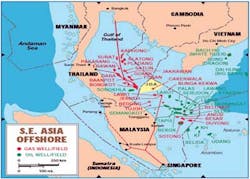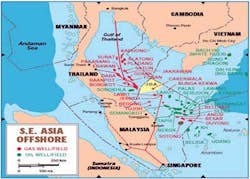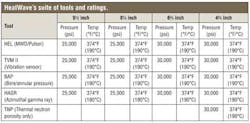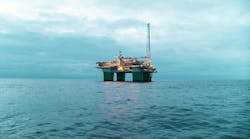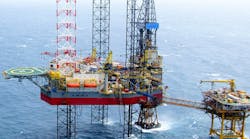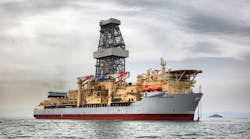Dick Ghiselin
Contributing Editor
Faced with increasing drilling and production prospects in that part of the world called the "Ring of Fire," operators and their service suppliers are turning up the heat to design, build, operate, and maintain high-pressure/high-temperature (HP/HT) tools and equipment.
To address the HP/HT issue requires a focused outlook. Wells can have high bottomhole temperature with moderate bottomhole pressures, or both high bottomhole pressures and high temperatures.
Another, more pervasive issue is time. Different well construction tools are only exposed to extreme conditions for a very short time, while others are expected to withstand HP/HT conditions for days or weeks. Production sensors may be expected to last for as much as 20 years at extreme conditions.
Acknowledging the first rule of energy, that it can never be created nor destroyed, engineers must also consider other forms of energy that may exacerbate the challenges of HP/HT. For example, the various forms of vibration created by the drilling environment can accelerate the effects of HP/HT on critical components such as electronics and sensors.
Trite but true, the expression, "A chain is only as strong as its weakest link," is also appropriate. How many million-dollar tools have failed because a 10-cent resistor burned out?
Tough challenges
The effects of elevated temperature and pressure can be insidious. Seals that are typically made from elastomers can only withstand so much temperature or pressure before they degrade and leak. When metal-to-metal seals are designed to overcome thermal and pressure issues, they can have challenges as well. Early logging tools designed for use in geothermal wells withstood temperatures of more than 600°F (315°C), but when exposed to ultra-high bottomhole pressures they took a permanent set. As the tools were withdrawn from the well, the crushed seals leaked and allowed the tool housings to become charged with superheated steam. This, in effect, turned the tool into a "bomb" that created severe burns on workers who tried to disconnect them on the catwalk. In one recorded case, high-pressure steam blew a 30-lb adaptor across the drill floor like a cannon ball.
Electrical circuits create their own heat when energized. This placed severe limits on early HP/HT tools, which literally "cooked themselves to death." Placing delicate electronics and sensors inside a Dewar flask protected them from outside heat, but concentrated all the inside heat from transformers, etc.
Sophisticated electronic logging instruments are like chains with a million "links," any one of which can become the weak link as the tool is cycled from ambient conditions to downhole heat and pressure. Often, when one link of an electrical circuit is broken, it causes an overload to appear elsewhere in the complex circuitry and failures cascade through the tool.
Over the years, innovative engineers have learned different ways to acquire the data they need in spite of HP/HT conditions. They play the "time" card. Where logging-while-drilling (LWD) tools must be able to withstand temperature extremes for days or weeks at a time, while experiencing high torsional, axial, and lateral vibration modes, wireline tools can acquire the same data with only a few seconds on bottom where conditions are at maximum. Vibration typically does not affect wireline tools because they are not run simultaneously with drilling.
There is no doubt that wireline measurements require that operators forgo the real-time aspect of while drilling measurements. This may be an unacceptable compromise that drives them to insist on LWD.
All things considered
Technical challenges aside, organizational changes can have beneficial effects as well. Many years ago, engineers observed that the number of wells whose bottomhole temperatures exceeded 250°F (121°C) was less than about 10% of total wells drilled. They also recognized that cyclic exposure to heat and pressure had a degrading effect on tool circuitry and pressure seals. This led to development of standard tool systems rated at 250°F, and 15,000 psi (1,034 bar) to perform the bulk of the work. They were able to build these tools using many off-the-shelf electronic components instead of the high-spec ones they had been using, thus saving money. The savings were devoted to designing and building an elite class of HP/HT tools that were rated (in the wireline case) to 500°F (260°C) and 25,000 psi (1,724 bar). These tools were strictly reserved for HP/HT wells, so they were only subjected to cycling about 10% of the time as the standard tools. Seals were changed after every descent, and tools were checked periodically in a heat oven.
Believed to be the world's record, a deep gas well in Webb County, Texas, with a measured bottomhole temperature of 555°F (290°C) was successfully logged by an induction-electrical logging tool. The tool was destroyed by the heat, but not before it acquired about 1,000 ft (305 m) of data that included the target interval. Techniques used to improve the odds of success included soaking the entire tool in ice before lowering it into the hole and leaving the tool turned off until it reached total depth so internal heat from transformers would not come into play until the last minute.
Though such tricks were successful for a few years, there was still strong demand for real-time measurements while drilling, both for improved drilling efficiency and for geosteering. LWD tools and rotary steerable systems (RSS) had to be upgraded so they could perform at extreme bottomhole conditions and for very long intervals. At the time, one of the weakest links was the battery. Early LWD instruments were powered by batteries, which are notorious for failure at temperature extremes. A recent solution is to power the downhole assembly using a mud-turbine generator, thus eliminating the batteries altogether. The obvious disadvantage is that the tools will only operate while mud is circulating. Recently, high-temperature battery reliability has been improved.
Unfortunately, the market for extreme HP/HT tools was widely scattered, with only a few, ultra-deep, ultra-hot, wells being drilled at any one time.
Displaying 1/2 Page 1,2Next>
View Article as Single page
